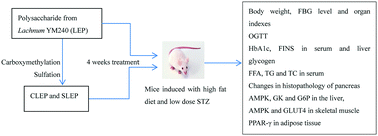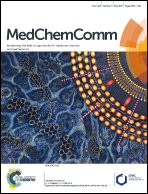Hypoglycemic and hypolipidemic effects of a polysaccharide from Lachnum YM240 and its derivatives in mice, induced by a high fat diet and low dose STZ†
Abstract
Carboxymethylated and sulfated polysaccharides (CLEP and SLEP) were prepared from an exopolysaccharide previously obtained from Lachnum YM240 (LEP) by chemical modifications. Two doses (50 mg kg−1 and 200 mg kg−1 b. w.) of LEP, CLEP and SLEP were orally administered to normal mice and type 2 diabetic mice (T2DM) that were induced by streptozotocin (STZ) and a high fat diet, respectively. The hypoglycemic effect was evaluated by testing the oral glucose tolerance, fasting blood glucose (FBG) levels, fasting serum insulin (FINS), glycosylated hemoglobin A1c (HbA1c), and the hypolipidemic effect was evaluated by the body, spleen, pancreas, liver and kidney weights, as well as serum triglycerides (TG), cholesterol (TC) and free fatty acids (FFA). After four weeks of administration, LEP, CLEP and SLEP showed a marked FBG fall rate of 11.2%, 44.0% and 42.5% for the high-dose and 7.43%, 38.5% and 33.1% for the low-dose, respectively, as compared to the DC group. Moreover, compared with DC mice, TC concentrations in the high-dose groups of LEP, CLEP and SLEP were significantly decreased by 29.6%, 38.7% (P < 0.05), 33.0% (P < 0.05), and TG concentrations decreased by 18.9%, 43.9% (P < 0.01), 29.0% (P < 0.05), respectively. In addition, LEP and the derivatives significantly upregulated the expression of glucokinase (GK) and adenosine monophosphate-activated protein kinase (AMPK) in the liver, AMPK and glucose transporter 4 (Glut4) in skeletal muscle and peroxysome proliferator-activated receptor (PPAR-γ) in adipose tissue, whereas downregulated the expression of glucose-6-phosphatase (G6P) in the liver; these were examined using ELISA detection kits. These results for FBG and serum lipids indicate that LEP and its derivatives possess significant hypoglycemic and hypolipidemic effects and carboxymethylation improved the hypoglycemic and hypolipidemic effects more effectively than sulfation. Therefore, the carboxymethylated and sulfated modifications were effective ways to enhance the hypoglycemic and hypolipidemic activities of polysaccharides.



 Please wait while we load your content...
Please wait while we load your content...